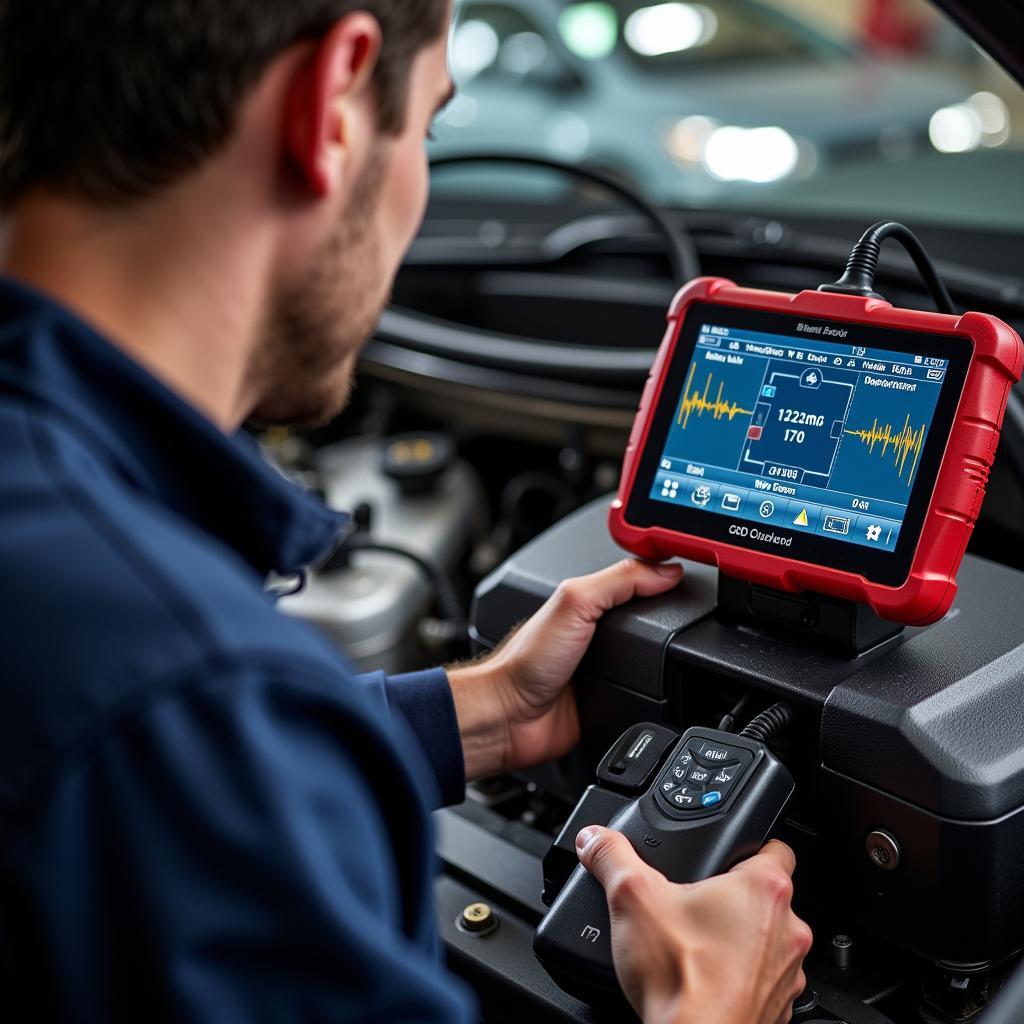When you connect a scan tool to your car’s OBD-II port, one of the data points you can read is the “SAE input voltage.” This reading can be crucial in diagnosing electrical problems in your vehicle. But what exactly does this reading mean, and why is it important?
Decoding the SAE Input Voltage Reading
Simply put, the SAE input voltage reading on your scan tool tells you the voltage level being received by your vehicle’s engine control unit (ECU) or powertrain control module (PCM). This voltage comes directly from your car’s battery and is essential for the ECU/PCM to function correctly.
Why is the SAE Input Voltage Reading Important?
The SAE input voltage reading is a critical indicator of your vehicle’s electrical system health. Here’s why:
- ECU/PCM Operation: Your car’s ECU/PCM relies on a stable voltage supply to function correctly. If the input voltage is too low or too high, it can cause a range of issues, from erratic engine performance to complete system failure.
- Sensor Accuracy: Many sensors in your vehicle rely on a specific voltage to operate accurately. A fluctuating or incorrect input voltage can lead to inaccurate sensor readings, triggering false error codes and hindering proper diagnostics.
- Battery Health: While not a direct measure of battery health, the SAE input voltage reading can offer clues about your battery’s condition. A significantly low reading, especially when the engine is off, can indicate a weak or failing battery.
Common Causes of Abnormal SAE Input Voltage Readings
Several factors can contribute to abnormal SAE input voltage readings:
- Weak or Failing Battery: A weak battery is a common cause of low input voltage. As batteries age, they lose their ability to hold a charge, leading to voltage drops, especially during cranking.
- Loose or Corroded Battery Terminals: Corroded or loose battery terminals can create resistance, preventing the battery from delivering the full voltage to the ECU/PCM.
- Faulty Alternator: The alternator is responsible for charging the battery and supplying power to the vehicle’s electrical system while driving. A failing alternator may not provide sufficient voltage, leading to low input voltage readings.
- Wiring Issues: Damaged, corroded, or loose wiring between the battery, alternator, and ECU/PCM can also cause voltage drops.
- Excessive Electrical Load: Running multiple high-draw electrical components simultaneously can put a strain on the electrical system, potentially leading to voltage drops.
Troubleshooting Abnormal SAE Input Voltage Readings
If your scan tool reveals an abnormal SAE input voltage reading, here are some troubleshooting steps you can take:
- Check Battery Voltage: Start by checking the battery voltage with the engine off. A healthy battery should read around 12.6 volts. If the reading is significantly lower, the battery may need to be charged or replaced.
- Inspect Battery Terminals: Examine the battery terminals for any signs of corrosion or looseness. Clean corroded terminals with a baking soda and water solution and tighten any loose connections.
- Test the Alternator: With the engine running, the alternator should provide a charging voltage of around 13.5 to 14.5 volts. If the voltage remains low, the alternator may be faulty and need replacement.
- Inspect Wiring: Carefully examine the wiring between the battery, alternator, and ECU/PCM for any signs of damage, corrosion, or loose connections. Repair or replace any damaged or corroded wires and secure any loose connections.
- Reduce Electrical Load: If the input voltage drops significantly when running multiple high-draw electrical components, try turning off unnecessary accessories to reduce the electrical load.
“A stable SAE input voltage is paramount for the proper functioning of your car’s electronics. Don’t ignore fluctuations in this reading, as they often point to underlying issues that need attention,” advises John Miller, Senior Automotive Electrician at ScanToolUS. “Timely diagnosis and repair can prevent further damage and ensure your vehicle’s electrical system operates flawlessly.”
When to Seek Professional Help
While the steps above can help identify and address common causes of abnormal SAE input voltage readings, it’s important to remember that diagnosing and repairing automotive electrical systems can be complex and potentially dangerous. If you are uncomfortable working on your vehicle’s electrical system or are unsure about any aspect of the diagnosis and repair process, it’s always best to consult a qualified automotive electrician or mechanic.
“Attempting to diagnose or repair electrical problems without proper knowledge and tools can be risky,” cautions Miller. “If you’re unsure about anything, it’s always safer to leave it to the professionals.”
Understanding your car’s electrical system and using a scan tool effectively can help you identify and address potential issues before they escalate. By paying attention to details like the SAE input voltage reading, you can ensure your vehicle’s electrical system remains healthy and reliable.
Need help with your car’s electrical system? Contact the experts at ScanToolUS at +1 (641) 206-8880 or visit our office at 1615 S Laramie Ave, Cicero, IL 60804, USA.

